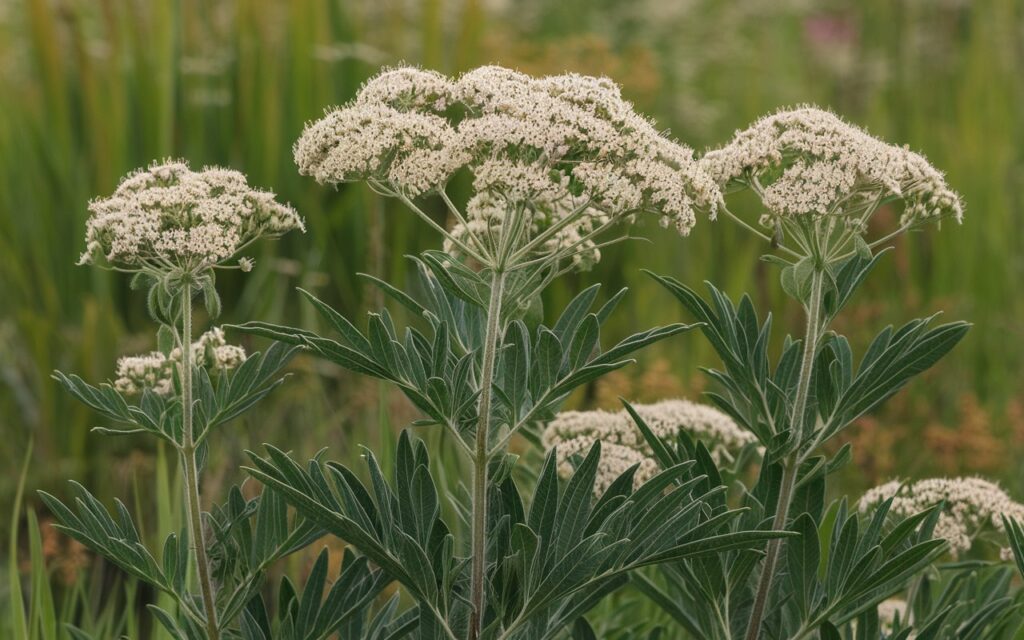Boneset (Eupatorium perfoliatum), a member of the Aster/Sunflower family, is renowned for its ability to treat fevers and respiratory conditions. Also known as feverwort, this North American perennial earned its name from its historical use in treating dengue fever, or “break-bone” fever, due to its effectiveness in alleviating the severe pain associated with the illness.
Identification and Habitat
Boneset is characterized by its erect, hairy stems, which grow between 2 to 4 feet tall and branch at the top. The plant’s large, opposite leaves are lance-shaped, finely toothed, and united at the base. Each leaf measures 4 to 8 inches in length and features prominent veins. The leaf surfaces are rough on top and downy with resinous dots underneath.
The plant’s numerous large flower heads are terminal, slightly convex, and consist of 10 to 20 white florets. These flowers have a slightly aromatic fragrance and a strongly bitter taste. Boneset blooms from July to September, and its size and appearance can vary.
Medicinal Uses of Boneset
Boneset has been traditionally used for a variety of health issues. Both the flowers and leaves are employed in its medicinal preparations, although drying them is recommended due to potential toxicity of fresh plants.
Colds, Flu, Bronchitis, and Congestion
Boneset is highly effective for treating common colds, flu, bronchitis, and other respiratory infections. It helps reduce mucus production, loosen phlegm, and eliminate it from the body. Additionally, it combats both viral and bacterial infections and induces sweating to help lower fevers. For best results, use boneset tincture early in the illness.
Dengue Fever (Break-Bone Fever)
Boneset is particularly beneficial for managing dengue fever, a mosquito-borne illness known for causing high fevers and severe muscle and bone pain. It alleviates fever and relieves pain, making it a valuable remedy in areas where dengue fever is a concern.
Malaria
Native Americans have historically used boneset to treat malaria. The herb promotes sweating, which helps reduce fever and lessen the severity of the disease.
Yellow Fever and Typhoid
Boneset is also used to address yellow fever and typhoid, primarily for its fever-reducing properties. While not as effective as in treating dengue fever or malaria, it still provides symptomatic relief.
Harvesting Boneset
To harvest boneset, collect the leaves and flowering stems during the summer, just before the buds open. Dry these parts for later use. Seeds ripen about a month after flowering and should be collected when the heads are dry, split, and the fluffy seed begins to float away. If seeds are gathered earlier, dry the seed heads for 1 to 2 weeks in open paper bags.
Warning and Precautions
- Pregnancy and Nursing: Boneset is not recommended for use by pregnant or nursing mothers, nor for young children.
- Long-Term Use: Avoid using boneset for extended periods due to potential toxicity.
Recipe: Boneset Infusion
To prepare a boneset infusion, follow these steps:
Ingredients:
- 1 ounce dried boneset leaf
- 1 quart (1 liter) boiling water
- 1 quart (1 liter) jar with a tight-fitting lid
Instructions:
- Place the dried boneset leaves into the jar and pour the boiling water over them.
- Tightly seal the jar and shake gently to mix.
- Allow the infusion to steep for 4 hours.
- Strain the infusion through a coffee filter or fine sieve.
- Warm the infusion before drinking, as it is quite bitter.
This infusion can be used hot to relieve fevers and treat colds, flu, and similar ailments. It can also be consumed cold as a tonic or tincture.
Conclusion
Boneset is a versatile herb with a rich history of use for treating various illnesses, particularly those involving fever and respiratory issues. While effective, it should be used with caution, especially during pregnancy, nursing, and for long-term use. For more herbal remedies, explore our Herbal Remedies Collection.
